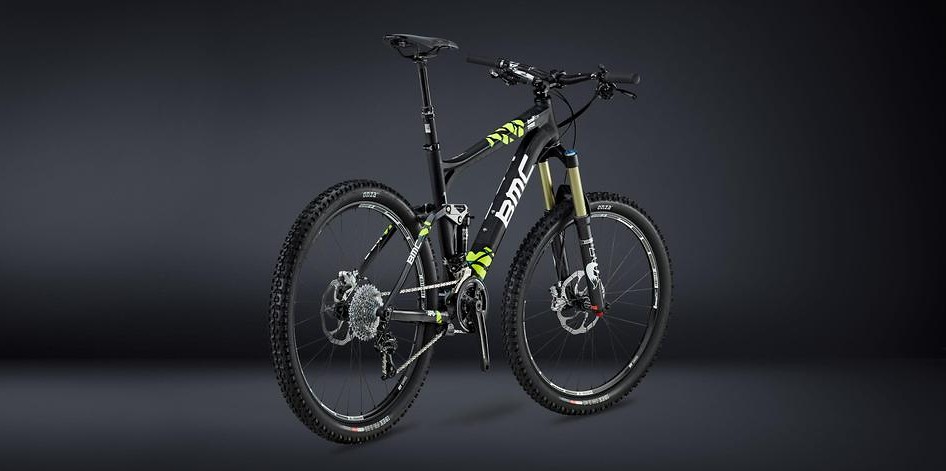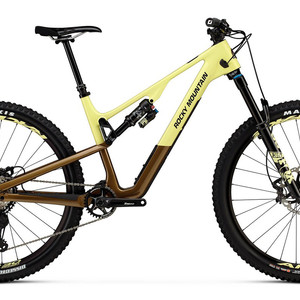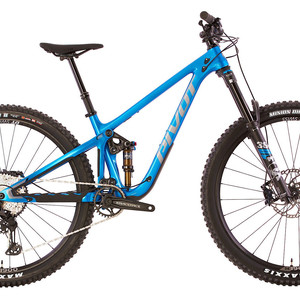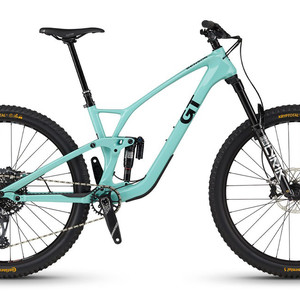2013 BMC Trailfox TF02 Trailcrew
(discontinued)
| Where To Buy | |||
|---|---|---|---|
Free shipping on orders over $50 (continental U.S. only).
International shipping available. Some exclusions apply. |
|||
Free shipping on orders over $50 (continental U.S. only).
International shipping available. Some exclusions apply. |
|||
Reviewed by Matt Thomson and Jess Pedersen // Written by Brandon Turman // Photos by Shawn Spomer and Brandon Turman
The BMC Trailfox is a 150mm travel all-mountain rig that BMC lovingly refers to as the "Swiss Army Knife" of their lineup. Much like that beloved pocket knife, the Trailfox was designed to come in handy for a variety of uses. The do-it-all bike is something many companies try to achieve, but few actually succeed. When Switzerland-based BMC set out to make the Trailfox, that's exactly what they had in mind, but did they pull it off? We invited the company to send over their mid-range TF02 model to find out during our 2013 Test Sessions in Southern Utah.

Trailfox TF02 Trailcrew Highlights
- Carbon front triangle, aluminum rear
- 26-inch wheels
- 150mm (5.9-inches) of rear wheel travel
- Tapered headtube
- 67-degree head angle
- 73-degree seat tube angle
- -13mm bottom bracket drop
- 430mm (17-inch) chainstays
- 12x142 thru-axle rear end
- Measured weight (size large, no pedals): 28-pounds, 6-ounces (12.87kg)
- MSRP $5999 USD
There are several models of the Trailfox, ranging from the full aluminum TF03 to the all carbon TF01. At $5999, the TF02 borrows the carbon front end from the flagship TF01 model and pairs it with an aluminum swingarm. There are two build options based around the TF02 frame, and we opted to go for the Trailcrew edition in favor of a bigger fork, bigger tires, and a chain guide. It's a good thing, too, because we rallied it down some pretty hairy trails.

When it comes to looks, BMC has a very distinct style across their entire range and the Trailfox is no exception. The rather "boxy" looking carbon front triangle features a "T" shaped top tube that runs at a slight angle back to the seat tube. At the seat tube junction, BMC uses what they call the Integrated Skeleton Concept (ISC) to connect the two tubes using a brace on the underside of the top tube, essentially flipping the conventional design in favor of less weight and increased stiffness. Also integral to the ISC equation are "skeletal reinforcement elements at the nodal points and the spread of the top tube" to help distribute forces.
Just below, a massive down tube brings the front triangle together along with the tapered headtube. BMC varies the headtube height depending on the size, and as a result our size Large test bike had a very tall headtube.
BMC took a few measures to help ensure the life of their frame by including a down tube protector for rock strikes, stainless steel deflection plate for chain-suck, and a chainstay protector for chain slap.
New for 2013, the frame features Stealth dropper post routing to help clean things up a bit. Cables run alongside the bottom of the down tube, and there is an optional set of guides on the top tube for a dropper post should you have to swap out the included RockShox Reverb Stealth.

Out back, a single tube on the non-drive side connects the chain and seatstays. The rear end also features an easy to remove 12x142mm rear axle, integrated 180mm disc brake post mounts, and a dongle-style chain slider mount on the drive side. Right off the bat, we did note some clearance issues with the swing arm after observing that the stock 2.25-inch Onza tire barely cleared. Running a bigger tire would simply be out of the question, and mud clearance is a definite concern.
Suspension wise, BMC uses a dual-link design they call Advanced Pivot System, or APS for short. It's activated by two forged aluminum links, and all four pivots use the same size of sealed cartridge bearings for ease of maintenance. Suspension setup is made easier thanks to a sag indicator on the upper rocker link. The shock is very accessible, well protected from debris, and it's an easy reach when changing to the various FOX CTD compression modes.
When it comes to efficiency, BMC says the APS design's "virtual pivot point is positioned so that constant chain tension is maintained for forward acceleration. As such, pedaling forces are used for forward propulsion with no loss of energy transfer in the suspension system."

Before we dive into the ride characteristics we observed while testing the Trailfox, a quick discussion of the bike's leverage curve is needed. As shown above, the design has a rising rate through the first two-thirds of travel before falling at the end of the stroke. Phrased another way, it's progressive at the beginning, requiring more and more force to compress the shock, and then the opposite near bottom out.
On The Trail
With Matt and Jess behind the bars, we took the Trailfox to two different trails. First, Matt put in a fair number of miles around the Guacamole area near Hurricane, Utah. The Guacamole network of trails consist of a never-ending series of steep ups, downs, and g-outs across some undulating Slickrock-esque terrain. Later, Jess pointed it straight down the rough and rowdy Grafton Mesa trail, which was the most technical, high-speed, all-mountain worthy trail we could find in the area.
Rolling out of the parking lot, the cockpit felt fine, but the stem was slightly too long for our tastes. On paper, this bike's geometry numbers look really good. It has a slackish 67-degree head angle and a reasonable bottom bracket height of 13.6-inches. Though the specs look favorable to descending, this simply wasn't the case while riding it, and what we experienced on the trail felt drastically different from what we had predicted.

On technical terrain, the bike's head tube angle felt noticeably steeper and top tube longer than other bikes in its class. With the stock 85mm stem, we felt a little too over the front end. Though this wasn't exaggerated, it was noticeable on steeper, technical descents and also made it more difficult to get the front up when needed. Because of this, the bike felt twitchy and the front wheel seemed to hang up in smaller holes that normally wouldn't have been a problem. The general sensation while riding this bike was that we were on top of and not in the bike.
Suspension performance was mixed bag as well, and ultimately we couldn't come to terms with the way this bike worked on aggressive terrain. At proper sag (as indicated by the handy gauge) and in FOX's "Trail" mode, sensitivity to small bumps just wasn't there, almost as though there was a large amount of stiction in the shock or pivots. It felt very rough over chatter and squared off hits, like it was riding too high in the travel. Surprisingly, it also tended to bottom out very easily on bigger hits. After removing all the air from the shock and cycling it through the full stroke, it was apparent that the suspension was very progressive at first and then blew through the travel at the end.
Looking back at the leverage curve, above, it's now clear why we experienced what we did. While most bikes that we'd characterize as fun and bottomless have a slightly progressive curve through the majority of the travel, the way the Trailfox was designed had us scratching our heads. This, combined with the geometry sensation, did not inspire confidence while descending. On the positive side, it did feel precise and there was no obvious feedback from heavy braking.

Pointed uphill, the bike's merits began to shine a little more brightly. The bike pedaled fine and felt supported while in the saddle. At 28.4-pounds it's pretty competitive in the weight game, especially for a bike with 150mm of travel and high volume tires. Although light for a bike in this genre, it felt heavier because of the poor suspension performance during hard out of the saddle efforts. Some bob was noticeable while really hammering, especially in the small ring. While we wouldn't call it call it sluggish, it wasn't extremely snappy either. Rolling speed was about the same. Big, techy climbing moves also felt really awkward due to the rear suspension's behavior.
Build Kit
Even with a decidedly European look, the Trailfox TF02 Trailcrew relies on a mostly standard list of components. Easton Haven carbon bars and stem, DT Swiss M 1800 tubeless wheels, a RaceFace Turbine 2X crankset, and the RockShox Reverb Stealth stand out as highlights. Each of them working perfectly well.

Up front, the FOX CTD Talas fork allows you to drop the travel from 150 to 120mm easily, even though we never felt the need to do so given the bike's moderate head angle.
Onza's 2.25-inch Ibex FR AM tire gave excellent turning grip up front, and the 2.25-inch Onza Canis rear tire complemented it well. They were good both on loose and loose over hard pack conditions, and were never unexpectedly drifty. Unfortunately they rolled slow, and one of the tires blew off the rim in an extreme g-out situation.
Paired with a 200mm rotor up front and a 180mm in the rear, the Avid Elixir 7 disk brakes proved to be reliable and trouble free. SRAM's Matchmaker system cleaned things up well by integrating the brakes, shifters, and Reverb remote into just one clamp per side. Note that the Reverb remote is on the rear shifter side, which can sometimes be awkward when simultaneously trying to shift and raise your post at the top of a climb.
While we've had good luck with SRAM's Type II X9 rear derailleur in the past, shifting was an issue on this bike. Despite a few adjustments, this bike did not shift crisply in the extreme ranges of the cassette and did not want to shift down properly. The chainstay mounted guide worked well in conjunction with the Type II derailleur to keep the chain on, but we could hear chain rub while pedaling in the upper two gears of the cassette. Aside from this noise, the Trailfox was as quiet as can be hoped for.
Long Term Durability
In terms of longevity, we have two major concerns with the Trailfox. First, there's a noticeable amount of flex when squeezing the top tube with your hands. This may prove to be a vulnerability if the bike goes down. Second, given the bike's tendency to bottom out often and harshly, the potential for blown rear shocks and bent shock hardware (or worse, a broken frame) are very real issues.

What's The Bottom Line?
Here at Vital, we like our bikes to perform under some pretty rigorous testing. We're aggressive riders and we need bikes that are up to the task to be able to ride confidently. The bottom line is that the BMC Trailfox TF02 Trailcrew did not live up to that expectation. We just couldn't come to terms with the poor rear suspension characteristics and the odd over the top ride sensation, and if you asked us to describe a trail that the bike would excel on, we'd honestly have trouble coming up with an answer - at least not the kind we like to ride. There is some very stiff competition in the $6000 price range, and until a few things get sorted, we suggest spending your hard earned dollars elsewhere. It's simply not the trusty Swiss Army Knife we hoped it would be.
Following Up
With our ride experience in hand, we reached out to BMC regarding their suspension design. This is the feedback we received:
"We first use our own software to define all the suspension characteristics including leverage ratios, pedal kickback, force response from shock, and axle path. We then simulate the behavior of the suspension within the same software, now taking into account the shock air volume and hydraulic characteristics. Our kinematics analysis described above defines our starting point with regards to shock air volume and hydraulic base settings. We work with Fox to adjust the air can positive chamber volume so that the bike feels plush, but progressive enough not to bottom out easily. We work extensively with Fox Europe to tune the air volume to give the ideal ride. Once we are happy with the shock's progression, we meticulously define rebound and compression shim stack settings. Finally we adjust IFP pressure to fine tune the balance between shock sensitivity and the influence of pedal action. Having a curve that is progressive to degressive is a very good thing as its designed to compensate for the innate progression of the air shock. What you feel on the bike is the combination these kinematics combined with the characteristics of the shock."
Ultimately, we can only comment on what we felt on the trail. We stand by our review and our feeling about the way the bike handled on that day.
For more information about the Trailfox, visit www.bmc-racing.com.
Bonus Gallery: 28 photos of the 2013 BMC Trailfox TF02 Trailcrew
About The Reviewers
Matt Thompson - Humble enough not to claim his Master's Downhill World Champ status when we asked him what his accomplishments were, Matt has over 20 years on a bike and likes to go fast. Really fast. At 210 pounds of trail building muscle, he can put the hurt on a bike in little to no time.
Jess Pedersen - Jess is one of those guys that can hop on a bike after a snowy winter and instantly kill it. He's deceptively quick, smooth, and always has good style. He's also known to tinker with bikes 'til they're perfect, creating custom additions and fixes along the way. Maybe it's that engineering background...
Specifications
| Where To Buy | |||
|---|---|---|---|
Free shipping on orders over $50 (continental U.S. only).
International shipping available. Some exclusions apply. |
|||
Free shipping on orders over $50 (continental U.S. only).
International shipping available. Some exclusions apply. |
|||

























7 comments
Post a reply to: 2013 Test Sessions: BMC Trailfox TF02 Trailcrew